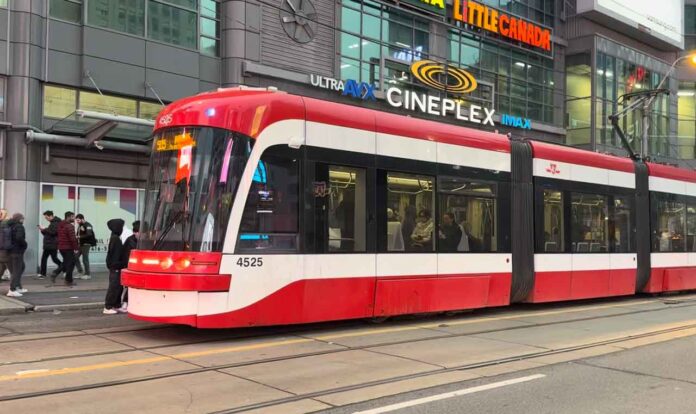Infra
A ‘storm coming’: GTA’s population growing faster than home starts, report finds | CBC News

The construction of new homes is not keeping pace with population growth across the Greater Toronto Area and housing affordability continues to worsen, says a new report commissioned by a group representing the region’s building industry — and the data shows the problem could get even worse.
The 2024 municipal benchmarking study, released Wednesday, found a decline in development applications for new projects threatens the region’s future housing supply.
The number of applications fell to 1,225 in 2023 from 2,482 in 2021 in the 14 municipalities that provided data, according to the study, conducted by market research firm Altus Group for the Building Industry and Land Development Association (BILD).
“It’s like you can see the storm coming,” said Noorez Lalani, president of high-rise developer MOD Developments.
“We’ve been throwing around the words ‘housing crisis,'” Lalani said. “It’s going to be a heck of a lot worse.”
WATCH | Affordable housing is scarce in Toronto:
BILD represents more than 1,000 GTA companies in home building, land development and renovation. This is the third study of its kind since 2020 looking at planning policy outcomes in 16 municipalities in the Greater Toronto and Barrie area.
While many of the municipalities are approving housing projects faster compared to the 2022 study, the report says the overall average timeline of 20.3 months remains “excessively high” — adding tens of thousands of dollars to the cost of building new homes.
Fees that governments, particularly municipalities, charge developers are also driving up housing costs, the report says. With Justin Sherwood, BILD’s senior vice president of communications and stakeholder relations, saying “fees, taxes and charges account for approximately 25 per cent” of the total cost of building a house.
“In the short term, unless we have immediate government action to lower costs that get added to the price of a house … and take steps to speed up approvals, we’re going to be looking at exacerbation or a worsening of the housing crisis in the GTA,” Sherwood said.
The findings highlight the challenge to meet the Ontario government’s target of building 1.5 million new homes between 2021 and 2031, at a time of high building costs, elevated interest rates and amid a labour shortage in the construction industry.
Lengthy approval times increase cost of housing: study
The study found the average time it takes to get a housing project approved in the municipalities decreased by 2.4 months compared to the last study in 2022.
Vaughan saw the largest decrease of 8.8 months, while Milton saw the highest increase of 13.1 months. Toronto’s approval timeline decreased by seven months, from an average of 32 months to 25.
Each month in which a project is tied up in the approval process adds between $2,673 to $5,576 in added cost per unit per month, according to the study. Between $43,000 and $90,000 can be added to the cost of a new home based on average approval times.
According to the study, municipal fees rose by an average of $42,000 per unit on low-rise residential buildings and $32,000 on high-rise units. The average price of a condominium rose by $122,387, while single-family homes increased by $164,920 as a result of fees, which include development, parkland dedication and community benefit charges.
“If we can get the government to work with municipalities to address approval time frames and reduce added costs, it’ll be a step in the right direction,” Sherwood said.
In a statement, a spokesperson for Housing Minister Paul Calandra said the province is “cutting red tape, streamlining approvals, and getting new homes under construction faster.”
“We removed the provincial portion of the HST on purpose-built rentals, which has led to the highest number of purpose-built rental construction starts ever seen in Ontario. We have also introduced an exemption of development charges for not-for-profit and affordable housing and development charge discounts of up to 25% on purpose-built rental family-friendly units,” Bianca Meta said.
Meta said the province is also investing $3 billion in “housing-enabling” infrastructure.
‘Weariness’ in industry, developer says
Lalani, from MOD Developments, said there is a feeling of “weariness” in the industry, and a reduction in taxes and development charges could provide relief to developers and home buyers alike.
The average family would have to devote 60 per cent of their monthly income to mortgage payments to afford a home in the highest cost areas of the Greater Toronto Area, which include Toronto, Mississauga, Vaughan and Oakville, the study found.
Jared Menkes, executive vice-president of high-rise residential at Menkes Developments, said his company is already seeing the slowdown play out.
He said the GTA currently has 88,000 high-rise residential units under construction in the GTA, but that number will shrink to around 5,000 units by 2027.
“Without any intervention today, I think we’re going to have double digit rent growth in the GTA and an unaffordability crisis,” he said.
The report shows encouraging signs that municipal planning staff are becoming more efficient despite struggling with staffing shortages and layers of red tape, said Karen Chapple, director of the school of cities at the University of Toronto.
She says there is also a problem of projects being approved but developers not building them due to a lack of financing or dwindling demand.
“Toronto folks often point out it’s not really a problem of how slow the staff is at the city level,” Chapple said. “It’s the overall economy and the fact that we can’t get through the existing pipeline, which we need to do before we go to the next pending applications.”










